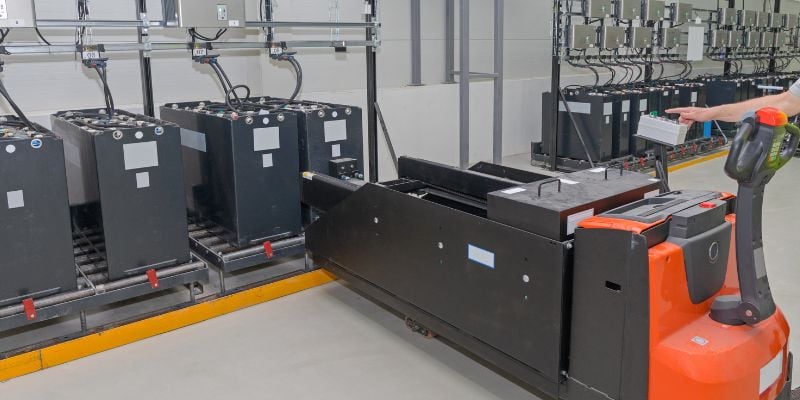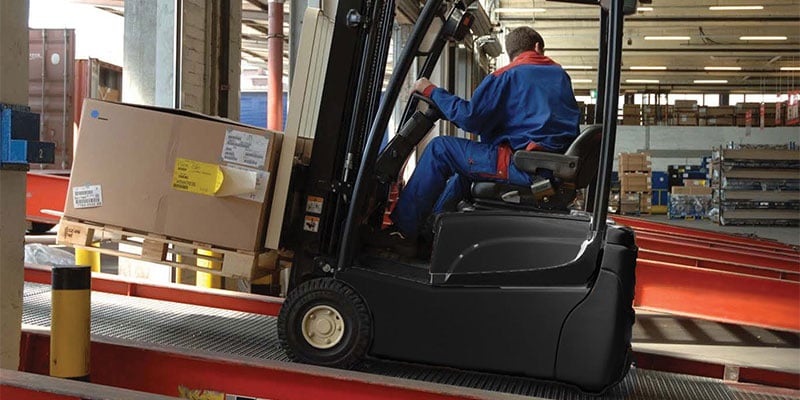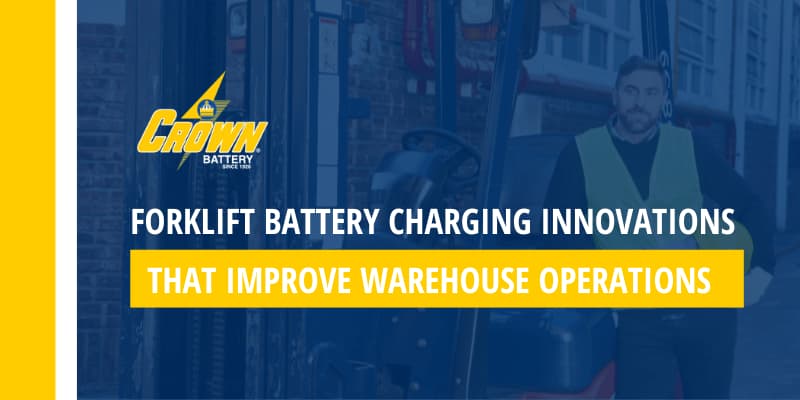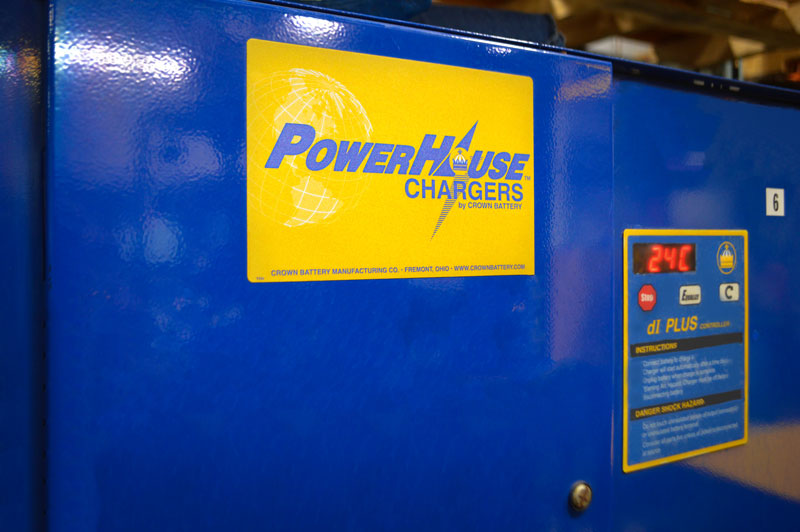Your battery charging practices can differentiate between profitable, continuous uptime vs. costly downtime and in-lease battery replacement.
Fortunately, there are accessible opportunities to boost efficiency, improve overall performance, and minimize equipment downtime and failure.
In the next few minutes, you’ll discover:
- How industrial battery charging evolved – and what it means for your operations.
- What makes opportunity charging and fast charging different?
- The easiest way to calculate your vehicle’s amp-hour usage.
- Key metrics and methods to ensure your battery lasts its entire lifecycle.
- Best practices to avoid downtime and boost safety and ROI
- And more.
How Has Industrial Battery Charging Evolved?
To understand industrial battery charging best practices, it helps to know a few key points about the most popular charging methods today – and how they impact your operations.
Initially, conventional charging for 3-shift applications involved:
- Daily battery changing.
- 8 hours of use, 8 hours of charging, and 8 hours of cooling.
- The start rate (amount of energy still available in a battery at the start of charging) was 15-20%, averaging 16.9%.
In the 2000s, companies like GM switched to Fast Charging:
- GOAL: Eliminate the need for two spare batteries – and eliminate the cost of buying additional assets.
- Charge at any opportunity instead of at the end of a shift.
- Aimed to return 20% to 80% per battery in 2 hours or less.
- Charging commenced at a start rate of around 40% of the Ampere-hour (Ah) capacity
- After 80% SOC, charging had to slow down due to concerns about gassing and heat generation.
Around 2007-2008, High-Frequency (HF) chargers gained popularity:
- The primary challenge was the connector. (SB-175 and SB-350 limited charging to 175A and 350A respectively.)
- Achieving higher amperage required multiple connectors or upgrading infrastructure.
- This led to higher costs for additional connectors, enhanced cabling, and potential transformer upgrades.
Today’s operations often eliminate or minimize battery swapping
Once the norm, battery changing is on the decline because it can cause:
- Lost time during changes: Imagine the downtime of driving to the changing station, changing the battery, and then driving back. Operators could quickly lose 20% of an hour every shift.
- Safety risks: The sheer weight of batteries can pose a significant hazard, especially for higher-capacity models.
- Cooldown time: Batteries generate less heat up to 80% SOC. But in conventional charging (with changing), batteries are often charged to 100%, which means additional heat buildup.
Instead of conventional battery changing, many industrial users are switching to newer charging methods.
What’s the difference between Opportunity Charging (OC) and Fast Charging (FC)?
In both scenarios, operators top off batteries whenever possible.
Opportunity Charging (OC):
- Usually starts at around 25%
- Otherwise, it is similar to fast charging in theory.
- Typically, it involves 4 - 6 hours of charging.
Fast Charging (FC):
- Typically starts around 40%
- Typically, it involves 2 hours of charge or less.
The ultimate goal for both FC and OC is to eliminate spare batteries, going from 3 to 2 batteries or even just 1.
Because FC and OC deplete a battery’s lifetime amp-hours faster, industrial battery users avoid returning lease batteries with a significant lifespan remaining. Otherwise, companies locked in a typical three-year lease might pay for two years of additional battery life they don’t use.
New charging methods require different lifespan calculations
With conventional charging, the before-charge and after-charge SOC were essentially the same, day in and day out. But that’s changing.
FC and OC deplete life amp-hours (Ah) faster because batteries are used more frequently – two or three shifts per day instead of just one.
That’s why manufacturers today measure batteries like "1.2 million Ah throughput over a battery's lifetime" – the total amount of energy batteries can store and release – instead of referencing conventional charging measurements like total cycles.
Best practice #1: Calculate your truck’s Ah Per Hour usage
You must know how many Ah your vehicle uses to:
- Avoid oversizing or charging batteries, which often results in extra heat.
- Prevent under-sizing or too-infrequent charging, which can kill batteries and lead to downtime.
- Optimize the SOC range (30% - 70% is often ideal).
- Allow you to make calculations like “6 am to 10 am @ 50 Ah per hour."
Data loggers are critical because they provide insights to plan efficient battery usage throughout the day and offer a good starting point for knowing your truck's energy usage.
Typically, experts utilize data loggers (aka power provers) in a simple process:
- Data loggers are zip-tied to the truck.
- They monitor amp-hour usage throughout the day.
- Your team or a battery specialist can collect this data and generate reports. (Crown Battery power specialists or your battery distributor can help here.)
A common mistake is to log data for a short amount of time. But experts know it’s vital to log data over an extended period:
- One week might be an anomaly.
- Two weeks can indicate a pattern.
- Three weeks provides a more accurate picture.
Once you have this information, managers can strategically plan charging sessions, considering aspects like lunch breaks and shift changes that might add an hour or two of energy to a battery.
Best practice #2: When sizing batteries, prepare for the future
Over the next 3-5 years, your business will probably change – and so will your energy needs. You’ll want to ensure your battery sizing and charging strategy is flexible and future-ready.
Your battery specialist can help you plan for operational changes such as:
- Expanding operations
- Adding or removing trucks
- Introducing new production lines
- Adding fans in the charging area
- Changes in operating conditions, such as new freezer applications or shifting to air-conditioned workspaces
- Using different truck modes and speeds
- Installing attachments on trucks
Best practice #3: Always make sure you hit the STOP button
Even with advanced protections, removing batteries from charge creates the risk of arcing. To avoid that:
- Ensure contacts are clean
- Size cables and connectors properly. (Your battery distributor or energy storage specialist can help with sizing.)
- Inspect contacts to ensure they aren’t pitted or burned – a frequent problem regardless of battery type.
- Permanently remove the cable from both ends, avoiding yanking from one side. (Overheated cables can impede charger performance.)
Best practice #4: Beware how changing your workday structure impacts charging
- Today, payment structures based on tasks are more common (e.g., picking 10K boxes daily), changing how operators use equipment and batteries.
- The time required for tasks varies.
- If one shift finishes work faster, they might inform the next shift that they can come in early – changing the charging profile and depleting batteries sooner.
- Charging mistakes have cascading effects over multiple shifts.
Best practice #5: Print and post simple, direct instructions for charging
Clear instructions help prevent common errors – and ensure employees follow best practices every time:
- Display visuals, like a person with a STOP sign pointing to the stop button.
- Encourage regular charging: “Plug in every opportunity you get.”
- Emphasize correct connections: “Make sure you plug into the battery, not the truck.”
- Schedule regular maintenance: “If it’s not Monday, don’t water your battery.”
- Consider displaying instructions in multiple languages (for instance, English and Spanish in the United States or English and French in Canada).
Best practice #6: Pick the right location for chargers.
Industrial battery chargers were located near lunchrooms for decades and charged during lunch breaks.
But this charge location falls flat if you use FC or OC – because batteries aren’t charged frequently enough.
Today, we recommend Point-Of-Use Charging—position equipment at its usage point, allowing for charging during downtime. More plug-in time ensures your battery lasts throughout the day.
Best practice #7: Get help from power specialists – because you don’t have to figure it all out alone.
Even the best operations managers often see only a few dozen sites or ways of running operations. But, industrial power specialists have seen the best practices and mistakes across dozens of industries.
Crown Battery’s experts have helped thousands of companies – they can help you get up and running or optimize your operations faster.
You’ll get clarity on choosing the right batteries and chargers, maximizing ROI, and ensuring you get the most out of your lease. There’s no cost, no obligation, and no risk. (Candidly, we’re betting you’ll think of us next time to choose batteries – but that’s up to you.)
You’ll even walk away with a detailed action plan that boosts battery efficiency and uptime. Just click the button below to get started.












